Łowienie na zestaw spławikowy jest naprawdę przyjemne dopiero wtedy, gdy ryby biorą jedna za drugą. Do złowienia dużej ilości ryb wcale nie jest potrzebny specjalny sprzęt.
Większość wędkarzy nie specjalizuje się w polowaniu na konkretne gatunki ryb. Niektórzy koledzy wybierają się na ryby tylko w ładną pogodę, inni spędzają nad wodą prawie cały rok. Nie zmienia to faktu, że jedni i drudzy mają cechę wspólną – każdy pragnie złowić możliwie najwięcej ryb. Jest to główna przyczyna, dlaczego dla większości wędkarzy tak naprawdę liczą się tylko dobre brania, a jaka ryba zawiśnie na haczyku nie ma już dużego znaczenia. Ze mną jest czasami dokładnie tak samo. I chociaż od wielu lat specjalizuję się w łowieniu okazów, to od czasu do czasu przyjemność sprawia mi łowienie małych ryb, pod warunkiem jednak, że biorą raz za razem. Latem tego roku urządziliśmy z kolegą zawody, kto złowi więcej wzdręg w małym stawie. Przez dwie godziny złowiliśmy ponad sto krasnopiórek i chociaż żadna z nich nie miała więcej niż 15 dekagramów, było to cudowne przeżycie (wszystkie ryby wróciły żywe do wody). Mieliśmy mnóstwo brań i było to tak przyjemne, że wracaliśmy do domu uśmiechnięci od ucha do ucha. O to właśnie powinno chodzić w wędkarstwie — najważniejsze są relaks i piękne doznania. Artykuł ten kieruję do wędkarzy, którym zależy, aby ich spławiki możliwie najczęściej znikały pod wodą.
Aby tak się stało, wcale nie musimy łowić na skomplikowane zestawy, używać wymyślnych przyponów ani wyszukiwać tajnych przynęt. Przeciwnie – metoda, która okazała się najskuteczniejszą jest prosta i sprawdzona. Skuteczna w wodzie stojącej oraz w ciekach o słabym prądzie. Rzeki o szybkim prądzie zostawmy prawdziwym fachowcom.
Białe robaki są najlepsze
Skuteczne łowienie na spławik możliwe jest dopiero po zrobieniu odpowiednich założeń. Jeżeli na przykład z trudem dorzucamy w wybrane miejsce nawet ciężkim zestawem spławikowym, to lepiej zdecydujmy się na zestaw gruntowy z ciężarkiem dennym.
Spławik powinien zawsze bez problemu dolatywać do celu. Nasze wędzisko nie może więc być zbyt krótkie – optymalna długość kija wynosi 3,5-4,0 metrów. Bezprzelotowe tyczki oraz wędziska bolońskie także zostawmy specjalistom.
Kij powinien być możliwie najlżejszy; w przypadku częstych brań będzie nam zależało na tym, aby przez cały czas trzymać wędzisko w ręku, a wtedy te kilkanaście gramów więcej może decydować o szybszym zmęczeniu.
O wiele ważniejsza od modelu kołowrotka jest żyłka. Powinna być dobrze rozciągliwa i na tyle silna, aby możliwa była walka z większą rybą. Dobrej jakości żyłka o wytrzymałości 2-3 kg jest wystarczająca. Miękkie i rozciągliwe żyłki są lepsze nawet od tych „superwytrzymałych”. Najchętniej używam haczyków matchowych (z łopatką i bardzo małym zadziorem) w rozmiarze od 16 do 22. Na większy haczyk zakładam trzy białe robaki, na mniejszy pojedynczego białego robaka lub castera. Uważam, że białe robaki są bezkonkurencyjne. Można je zawsze i wszędzie kupić, a następnie, bez żadnych przygotowań, od razu założyć na haczyk. Białe robaki nadają się też do nęcenia, długo trzymają się na haczyku, a na jednego białego robaka można złowić nawet kilka ryb. I najważniejsze: biorą na nie prawie wszystkie gatunki ryb.
O poczwarkach (casterach) wspomniałem dlatego, że niekiedy są one jeszcze łowniejsze od białych robaków i na dłużej zatrzymują stado ryb w łowisku. Latem zaś otrzymujemy castery prawie automatycznie – w każdym pudełku z białymi robakami kilka z nich zawsze się przepoczwarza…
Zanęta powinna eksplodować
Odradzam łowienie na duże odległości. Im mniejszy dystans, tym precyzyjniejsze są rzuty i nęcenie. Większość ryb i tak stoi w pobliżu brzegu.
Zostańmy jeszcze przy nęceniu. Skład mojej zanęty na ryby spokojnego żeru jest następujący:
• 40 procent mączki biszkoptowej
• 40 procent delikatnej panierki
• 20 procent gotowej zanęty. Zanętę kupujemy według własnego uznania. Wystarczy tylko, aby pomyślana była na wodę stojącą oraz na niezbyt duże ryby.
Gotowa zanęta nadaje całej masie zanętowej odpowiedni aromat, posiada też składniki ułatwiające rozpadanie się kul w momencie zetknięcia się z wodą. Jest to bardzo ważne. Tak samo istotne jest dokładne wymieszanie komponentów zanęty, gdy jest jeszcze sucha. Dopiero wtedy, powoli i z wyczuciem dodajemy wodę.
Ale uwaga – lepiej żeby masa zanętowa była trochę za sucha, niż za mokra. Jeżeli zanęta daje się formować w kule przy lekkim ściśnięciu w ręce, oznacza to, że ma ona poprawną konsystencję.
Zanim zaczniemy nęcić czekamy około dziesięciu minut, aby masa zanętowa dobrze nasiąkła wodą. Kula wykonana z zanęty o poprawnej konsystencji powinna „eksplodować” w momencie uderzenia o powierzchnię wody i rozpadać się już w trakcie opadania na dno.
Na początek wystarczą dwie, trzy kule wielkości piłeczki golfowej. Następne kule wrzucamy do wody w regularnych odstępach czasu. Jeżeli ryby biorą słabo lub w ogóle, nęcimy bardzo oszczędnie.
W przypadku dobrych brań powinniśmy donęcać większą ilością zanęty. Lepiej jednak wrzucić do wody więcej takich samych kul, niż zwiększać ich objętość!
Do proponowanego sposobu łowienia gorąco polecam prosty spławik typu waggler – im mniejszy, tym lepszy. Spławik powinien być tak wyważony, aby antenka jak najmniej wystawała z wody. Przy planowaniu obciążenia zestawu powinniśmy wziąć poprawkę na pojedyncze śruciny. Wskazane jest bowiem, aby dwie śruciny były zaciśnięte w równomiernych odstępach na żyłce pomiędzy spławikiem a przyponem (rysunek 1).
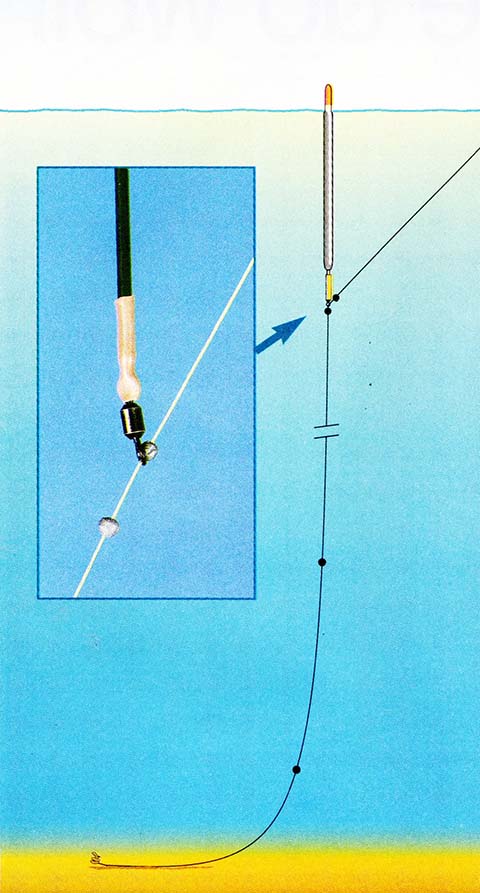 Rysunek 1: spławik typu waggler z antenką jest czułym sygnalizatorem brań. Po użyciu łącznika (zdjęcie) do zamontowania spławika, możemy go zmienić na inny model. Uszko spławika zablokowane jest dwoma śrucinami. Pozostałe dwie znajdują się w połowie odległości pomiędzy spławikiem a haczykiem (większa śrucina) oraz 30 cm nad haczykiem.
Rysunek 1: spławik typu waggler z antenką jest czułym sygnalizatorem brań. Po użyciu łącznika (zdjęcie) do zamontowania spławika, możemy go zmienić na inny model. Uszko spławika zablokowane jest dwoma śrucinami. Pozostałe dwie znajdują się w połowie odległości pomiędzy spławikiem a haczykiem (większa śrucina) oraz 30 cm nad haczykiem.
Zamontowanie spławika do żyłki głównej poprzez łącznik (nasadowy lub z gwintem) pozwala na szybką zmianę spławika na model o innej wyporności lub z antenką w innym kolorze.
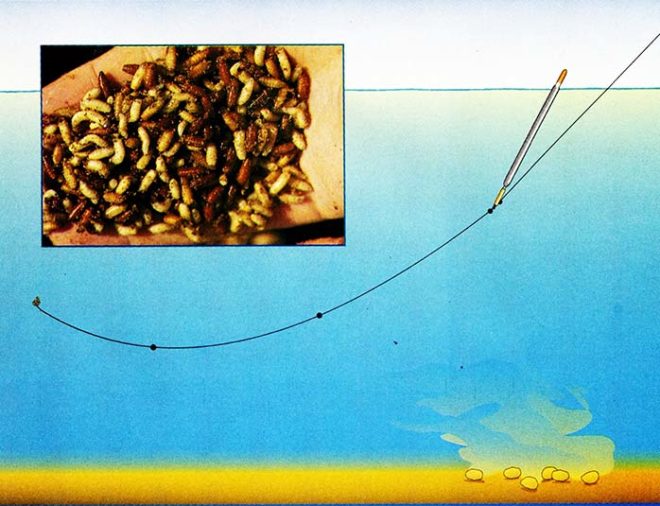
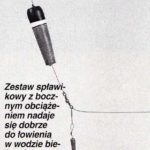
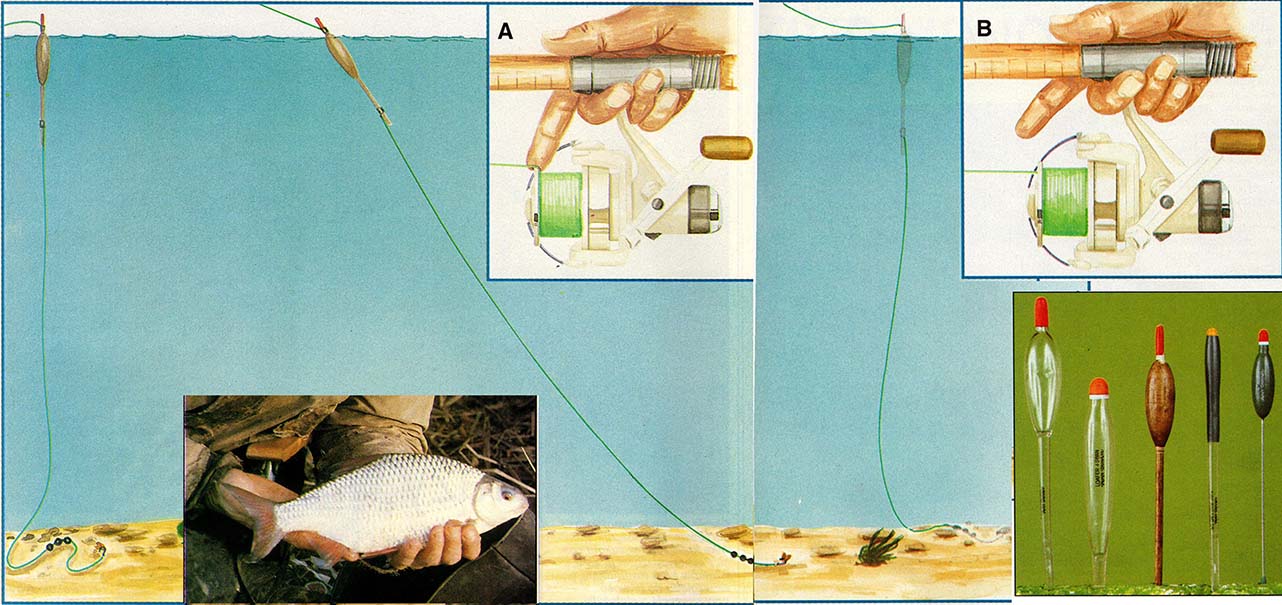
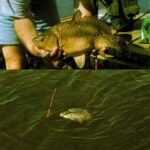
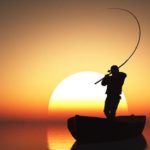

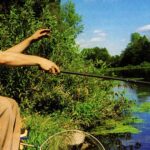
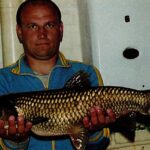

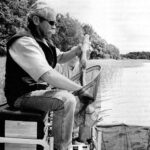
Witam, czytałem że rozkładanie ciężarków na przykład po przez rozdzielenie ich stoperem może być dobre i warto je stosować, czy to faktycznie warto robić? Oraz pytanie drugie, czy lepiej wykorzystać spławik na przelotce czy czasami lepiej sprawdzi się taki na mocowaniu przez koszulki?